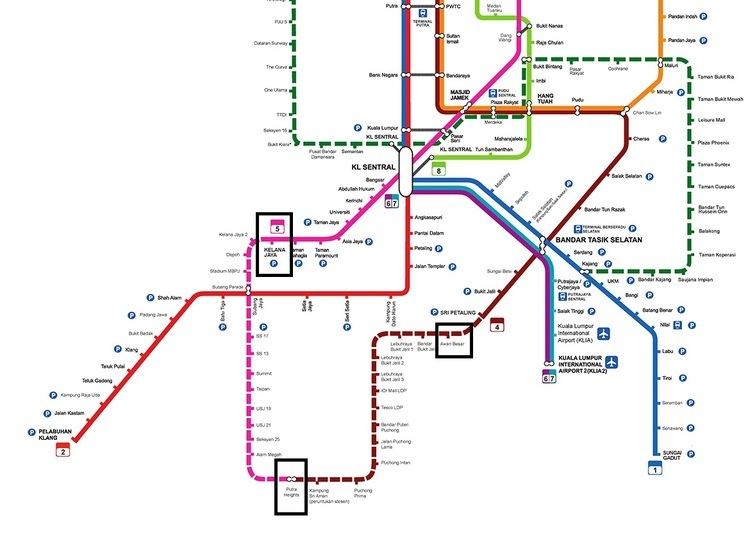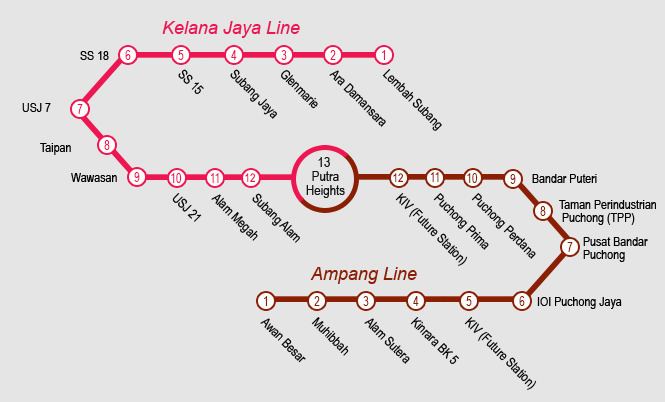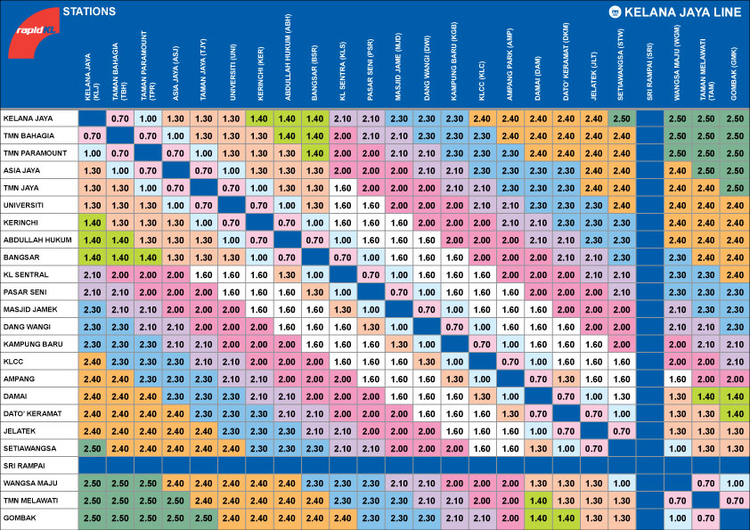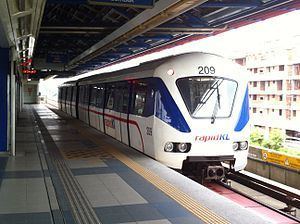Status Fully Operational | Type Light rapid transit Stations 37 | |
 | ||
System LRT KL System 2 (LRT2) - SelTrac CBTC Services i) Gombak - Putra Heightsii) Gombak - Ara Damansara Similar Keretapi Tanah Melayu, Sabah State Railway, Federated Malay States Railways | ||
Rapidkl adds 14 new trains on kelana jaya line
The LRT Kelana Jaya Line is the fifth rail transit line and the first fully automated and driverless rail system in the Klang Valley area. It is a part of the Greater KL/Klang Valley Integrated Transit System under the Land Public Transport Commission of Malaysia (SPAD). The line is numbered 5 and coloured ruby on the official transit map.
Contents
- Rapidkl adds 14 new trains on kelana jaya line
- Lrt kelana jaya line extension lrt train ride at dusk
- Stations
- Extensions
- Rolling stock
- History
- Chronology
- References

Lrt kelana jaya line extension lrt train ride at dusk
Stations

The line runs from Putra Heights through Kelana Jaya to Gombak, serving the Subang Jaya and Petaling Jaya regions to the south; southwest and central Kuala Lumpur, and Kuala Lumpur City Centre to the centre; and low density residential areas further north.
At 46.4 km in length, it is one of the longest fully automated driverless metro system in the world.

The stations are given in a north-south direction, consists primarily of elevated stops and a handful of underground and at-grade stations. Of the 37 stations, 31 are elevated, (Sri Rampai) lies at ground level, and 5 stops (Masjid Jamek, Dangi Wangi, Kampung Baru, KLCC and Ampang Park) are underground.

The stations, like those of the Ampang Line, are styled in several types of architectural designs. Elevated stations, in most parts, were constructed in four major styles with distinctive roof designs for specific portions of the line. KL Sentral station, added later, features a design more consistent with the Stesen Sentral station building. Underground stations, however, tend to feature unique concourse layout and vestibules, and feature floor-to-ceiling platform screen doors to prevent platform-to-track intrusions. 13 stations (including two terminal stations and the five subway stations) utilise a single island platform, while 11 others utilize two side platforms. Stations with island platforms allow easy interchange between north-bound and south-bound trains without requiring one to walk down/up to the concourse level.

The stations were built to support disabled passengers, with elevators and wheelchair lifts alongside escalators and stairways between the levels. The stations have platform gaps smaller than 5 cm to allow easy access for the disabled and wheelchair users. They are able to achieve this with:


The stations are the only rapid transit stations in the Klang Valley designed to provide a degree of accessibility for handicapped users.
The stations have closed-circuit security cameras for security purposes.
Extensions
On 29 August 2006, Malaysian Deputy Prime Minister Mohd Najib Abdul Razak announced that the western end would be extended to the suburbs of Subang Jaya which are USJ and Putra Heights to the south-west of Kuala Lumpur. The extension will be part of a RM10 billion plan to expand Kuala Lumpur's public transport network.
The expansion plan will also see the Ampang Line extended to the suburbs of Puchong and the south-west of Kuala Lumpur The plan also involved the construction of an entirely new line, tentatively called the Kota Damansara-Cheras Line, running from Kota Damansara in the western portion of the city, to Cheras which lies to the south-east of Kuala Lumpur.
As of August 2008, Syarikat Prasarana Negara was reportedly running land and engineering studies for the proposed extension.
In September 2009, Syarikat Prasarana Negara began displaying the alignment of the proposed extensions over a 3-month period for feedback. The Kelana Jaya extension will see 13 new stations over 17 km from Kelana Jaya to Putra Heights. Construction is expected to commence in early-2010.
On November 2010, Prasarana announced that it has awarded RM1.7 billion for first phase of the project. The winners include Trans Resource Corp Bhd for the Kelana Jaya line extension. UEM Builders Bhd and Intria Bina Sdn Bhd were appointed as subcontractors for the fabrication and supply of segmental box girder jobs for the Kelana Jaya line.
Construction works on the Kelana Jaya Line and the Ampang Line Extension project are targeted to escalate at the end of March, with commencement of structural works, subject to approval from state government and local authorities.
As of 2014, completion of the extension is targeted for 2016. Refer to the previous table in Line and Station section above.
On 14 April 2016, Prasarana Malaysia confirmed in a media release that the Kelana Line extension will be fully operating on 30 June 2016.
Rolling stock
The rolling stock, in use since the opening of the line in 1998, consists of 35 Innovia Metro 200 (ART) trains with related equipment and services supplied by the Bombardier Group and train electronics company Quester Tangent. They consist of two-electric multiple units, which serve as either a driving car or trailer car depending on its direction of travel. The trains utilise linear motors and draw power from a third rail located at the side of the steel rails. The plating in between the running rails is used for accelerating and decelerating the train. The reaction plate is semi-magnetised, which pulls the train along as well as helps it to slow down.
The ART is essentially driverless, automated to travel along lines and stop at designated stations for a limited amount of time. Nevertheless, manual override control panels are provided at each end of the trains for use in an event of an emergency.
The interior of the ART, like its Ampang Line counterparts, consists of plastic seating aligned sideways towards the sides of the train, with spacing for passengers on wheelchair, and spacing in the middle for standing occupants. Since its launch in 1998, the ART rolling stock has remained relatively unchanged; only more holding straps have been added and the labeling has been modified from Putra-LRT to RapidKL. Some of the rolling stock has the majority of the seats removed for added passenger capacity during rush hours.
On 13 October 2006, Syarikat Prasarana Negara signed an agreement with Bombardier Hartasuma Consortium for the purchase of 88 Mark II ART cars (22 train sets of 4-cars) with an option for another 13 for RM1.2 billion. The 22 train sets, initially targeted to be delivered from August 2008 onwards, will have four cars each and will boost the carrying capacity of the fleet by 1,500 people. On 8 October 2007, Syarikat Prasarana Negara exercised its option to purchase an additional 52 Mark II ART cars (13 train sets of 4-cars) for €71 million, expected to be delivered in 2010.
Although the trains were expected to arrive in August 2008, the delivery was delayed to November 2008 by the manufacturer. Rapid Rail said that the trains will only be usable by September 2009 after having sufficient rolling stocks, power line upgrades and safety testing. Transport Minister, Datuk Seri Ong Tee Keat has said in Parliament that the new trains will begin operations by December 2009. However, in July 2009, Prime Minister Najib Tun Razak announced that the four-car trains will only be fully operational by end-2012.
On 30 December 2009, 3 of the 35 new four-car trains entered commercial service. New features other than increased capacity up to 950 passengers per trip are seat belts for wheel-chair bound travelers, door alarm lights for hearing impaired and more handles for standing commuters.
The Kelana Jaya Line fleet consisted of the following models:
The old RM 10 banknote of the 1996 series featured an image of a Kelana Jaya Line train.
History
The first operation commenced on 1 September 1998 between Subang Depot and Pasar Seni, with phase two, Pasar Seni to Terminal Putra, in June 1999.
In 2002, the line carried its 150 millionth passenger, with an average of 160,000 passengers daily. Today, it carries over 190,000 passengers a day and over 350,000 a day during national events.
The line is slated for a 17 km extension, with construction anticipated to start in early 2010 and continue through 2012. This expansion will introduce 13 new stations, extending the line to a new terminus at Putra Heights from Kelana Jaya.
The Kelana Jaya Line was known as PUTRA LRT, "PUTRA" standing for Projek Usahasama Transit Ringan Automatik Sdn Bhd, until the company was taken over by its current owner Prasarana Malaysia.
